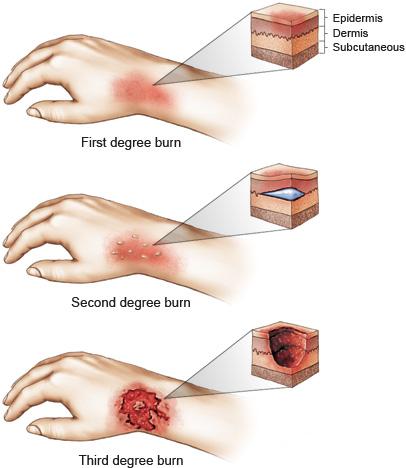
IIA: The epidermis and the superficial layers of the dermis are degraded. Additionally, these burns can be divided into the so-called mosaic types. In the course of this type of burn, the epidermis and the dermis are damaged. Partial-thickness superficial burns (II degree). Sunburn is the most common cause of this type of burn. There is no visible scar after this type of burn. The damaged epidermis peels off after 5–10 days. Called erythema, these cover the epidermis, accompanied by redness, slight swelling, and pain that subsides after 48–72 h. Classification of Burns According to the Depth of the Wound The aim of this review is to examine the literature concerning aspects of burn types, measurements of burn surface area, the most common complications during the healing process, new treatment methods, and their use in clinical practice.Ģ. Additionally, the appearance of secondary infections negatively affects the general condition of the patient, prolongs hospitalization and convalescence, while significantly increasing the cost of treatment. The moist wound environment itself promotes adhesion, the multiplication of microorganisms, and the development of infection, which can be both exogenous and endogenous. Despite many preventive measures, various types of complications may arise during the therapeutic process. Currently, there are several hydrogels, hydrocolloid, and hydro fiber dressings available on the market. Appropriate treatment of the injury translates into therapeutic success, but so far ideal dressings for burn wounds have not been developed and implemented on a large scale that would allow their complete self-healing without constant control and care. Conservative treatment alone in the case of deep and extensive burn wounds is often insufficient due to the poor general condition of the patient. With deeper lesions, patients often require surgical intervention with the excision of irreversibly changed tissue.

Initial clinical assessment of the burn area is often difficult and may be associated with incorrect classification, especially for moderate-degree burns. When admitting a patient to the ward, several factors should be considered, ranging from the cause of the injury, the extent of the lesions, and tissue penetration. Nevertheless, treating burn wounds remains a challenge.
:max_bytes(150000):strip_icc()/20130803-094920-11-56a2f5665f9b58b7d0cfdf4d.jpg)
The second half of the 20th century brought intensive development of regenerative medicine, burn therapy, and pharmacotherapy. Until the first half of the 20th century the treatment of burn patients was very limited, and patients very often died because of hypervolemic shock in the first days after injury. Globally, burns are the fourth most frequent type of injury, after traffic accidents, falls and physical violence.


 0 kommentar(er)
0 kommentar(er)
